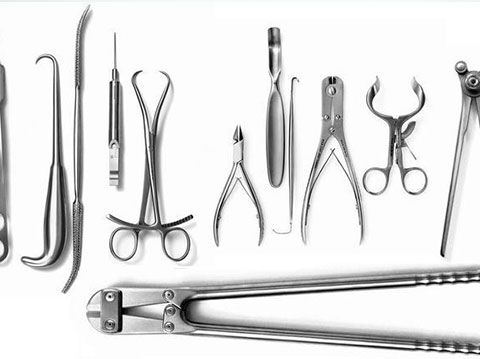
Orthopaedic Instrument in Uganda

An orthopaedic instrument is a specialized surgical tool used by surgeons during orthopaedic operations to implant, fix, or remove orthopaedic devices, and to manipulate bone and soft tissues. These instruments are usually made of high-grade stainless steel to ensure durability, corrosion resistance, and sterilizability.
Examples: Bone cutters, drills, reamers, forceps, retractors, curettes, saws, hammers, chisels, screwdrivers, and plate benders.
Purpose: To assist in precise surgical procedures such as cutting, drilling, shaping, or fixing bones and positioning orthopaedic implants.
Orthopaedic Instruments = Tools used by surgeons to perform orthopaedic surgeries and handle implants.
| Bone Cutting Instruments | Bone cutters, nippers, osteotomes, chisels, saws (manual and power), and Gigli wires are used for bone resections, osteotomies, or implant removal |
| Holding & Positioning Instruments | Bone-holding forceps, plate holders, bone levers, and reduction clamps ensure bones and implants are held securely during fixation |
| Drills, Drill Bits & Screwdrivers |
Drills and bits create pilot holes in bone for screws or implant placement. Screwdrivers come in multiple drive types (e.g., hex, torx) and may be auto-retaining to simplify screw insertion and removal |
| Bone Taps | Create threads in bone to anchor screws firmly, ensuring stability and precision |
| Retractors, Curettes & Rongeurs |
Retractors (e.g., Hohmann, Bennett) hold soft tissue or bone aside to expose the surgical field Curettes and rongeurs remove bone or debris and prepare bone surfaces for implant seating |
| Mallets & Impactors | Orthopaedic mallets and chisels are used to drive instruments or implants into place (e.g., compacting a prosthetic component) |
| Measuring & Alignment Tools | Tools such as calipers, depth gauges, and alignment guides ensure accurate bone cuts and implant positioning, critical for long-term implant function and patient outcome |
| Specialty Tools | Instruments specialized for external fixators, spinal systems, nail insertion, arthroscopy, and specific implant systems are supplied in dedicated sets to streamline surgical workflows |
|
High-Quality Material |
Usually made of surgical-grade stainless steel, titanium, or other alloys that resist corrosion, rust, and wear. |
|
Durability & Strength |
Designed to withstand repeated use, high mechanical stress, and sterilization cycles without losing efficiency. |
|
Precision & Accuracy |
Engineered for exact cutting, drilling, holding, and shaping of bones and implants, ensuring surgical accuracy. |
|
Ergonomic Design |
Handles shaped for surgeon comfort, reducing fatigue during long orthopaedic surgeries. |
|
Variety of Types |
Includes cutting instruments (saws, osteotomes), holding instruments (forceps, clamps), drilling/tapping tools (drills, screwdrivers), and measuring tools (calipers, depth gauges). |
|
Corrosion & Heat Resistance |
Able to tolerate autoclaving (steam sterilization) and exposure to body fluids without degradation. |
|
Compatibility with Implants |
Designed to work seamlessly with orthopaedic implants (screws, plates, nails, prostheses) for secure fixation and removal. |
|
Multiple Sizes & Variants |
Multiple Sizes & Variants |
|
Reusable or Disposable Options |
Most are reusable after sterilization, while some delicate or specialized instruments may be disposable. |
|
Safety-Oriented |
Smooth finishing to minimize tissue trauma, with non-slip grips for safe handling. |
|
Specialized Functionality |
Cutting → saws, chisels, osteotomes Holding → clamps, forceps, bone-holding forceps Fixation → screwdrivers, drills, taps Exposure → retractors, elevators Measuring → depth gauges, calipers |